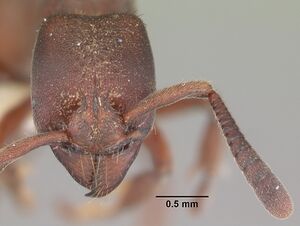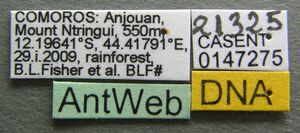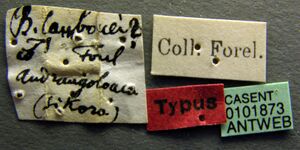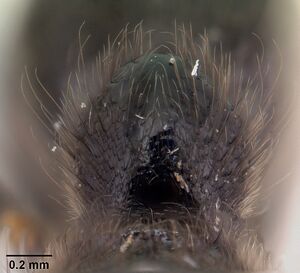Bothroponera cambouei
| Bothroponera cambouei | |
|---|---|

| |
| Scientific classification | |
| Kingdom: | Animalia |
| Phylum: | Arthropoda |
| Class: | Insecta |
| Order: | Hymenoptera |
| Family: | Formicidae |
| Subfamily: | Ponerinae |
| Tribe: | Ponerini |
| Genus: | Bothroponera |
| Species: | B. cambouei |
| Binomial name | |
| Bothroponera cambouei Forel, 1891 | |
| Synonyms | |
| |
Endemic to Madagascar. Although this species is generally terrestrial, a few specimens have been found foraging on low vegetation. Forms occur on the mountaintops, and in lowland forests. Most forage through leaf litter and rarely on the forest floor. Nest series were discovered for most forms, collected frequently from rotten logs, under stones, in the ground, in rotten tree stumps, and between root mat layers, but seldom in dead twigs or branches above the ground. Workers of P. cambouei often play dead when their nests are disturbed. Colonies of 2 forms have not yet been found, which suggests they may be soil dwellers. The smaller eyes, longer erect hairs, and abundant pubescence of one of these 2 forms are suggestive of an underground life style. (Rakotonirina & Fisher, 2013)
Identification
Rakotonirina & Fisher (2013) - With head in full-face view, antennal scape not surpassing posterior cephalic margin; dorsum of head and mesosoma not finely striate; dorsum of the body with erect slender hairs and pubescence; basal half of antennal scape rounded; dorsal outline of mesosoma not forming a continuous convexity; distinct angle discernable between propodeal dorsum and declivitous surface; petiole nodiform, not anteroposteriorly flattened; anterior half of fourth abdominal tergite (gastral tergite 2) mostly smooth and shiny between large punctures.
Bothroponera cambouei shows a remarkable range of phenotypic diversity. To faciliate discussion of this diversity, the morphological characters of the worker caste are divided into seven forms on the basis of the shape of the occipital corner, the posterior margin of the head, the size of the eyes, the form of the mesosoma, and the abundance of pubescence on the fourth abdominal tergites. However, there is no simple pattern to the degree of variation of these forms. Specifically, a few forms have very restricted geographic boundaries while others show a wide distribution along the humid forests of Madagascar.
Keys including this Species
Distribution
B. cambouei is an endemic, widespread species found from the north throughout the center and the south of Madagascar. It occupies mainly mesic forests at higher and lower altitudes, and also occurs in littoral and transitional forest habitats. This species dominates the representatives of the genus Pachycondyla across its distribution range. Two or more different forms within the species occur sympatrically in several localities.
Latitudinal Distribution Pattern
Latitudinal Range: -12.25889° to -25.06167°.
| North Temperate |
North Subtropical |
Tropical | South Subtropical |
South Temperate |
- Source: AntMaps
Distribution based on Regional Taxon Lists
Malagasy Region: Madagascar (type locality).
Distribution based on AntMaps
Distribution based on AntWeb specimens
Check data from AntWeb
Countries Occupied
| Number of countries occupied by this species based on AntWiki Regional Taxon Lists. In general, fewer countries occupied indicates a narrower range, while more countries indicates a more widespread species. |

|
Estimated Abundance
| Relative abundance based on number of AntMaps records per species (this species within the purple bar). Fewer records (to the left) indicates a less abundant/encountered species while more records (to the right) indicates more abundant/encountered species. |

|
Biology
Castes
Worker
Images from AntWeb
   
| |
| Lectotype of Bothroponera cambouei. Worker. Specimen code casent0101770. Photographer April Nobile, uploaded by California Academy of Sciences. | Owned by MHNG, Geneva, Switzerland. |
   
| |
| Worker. Specimen code casent0102411. Photographer April Nobile, uploaded by California Academy of Sciences. | Owned by NHMUK, London, UK. |
   
| |
| Worker. Specimen code casent0147275. Photographer Erin Prado, uploaded by California Academy of Sciences. | Owned by CAS, San Francisco, CA, USA. |
     
| |
| . | |
Male
Images from AntWeb
    
| |
| Male (alate). Specimen code casent0101873. Photographer April Nobile, uploaded by California Academy of Sciences. | Owned by MHNG, Geneva, Switzerland. |
       
| |
| Male (alate). Specimen code casent0497079. Photographer April Nobile, uploaded by California Academy of Sciences. | Owned by CAS, San Francisco, CA, USA. |
Additional montage images for this species can be found here
Nomenclature
The following information is derived from Barry Bolton's Online Catalogue of the Ants of the World.
- cambouei. Bothroponera cambouei Forel, 1891b: 133, pl. 4, fig. 7 (w.q.) MADAGASCAR.
- Type-material: lectotype worker (by designation of Rakotonirina & Fisher, 2013a: 107), 1 paralectotype worker, 3 paralectotype queens.
- Type-locality: lectotype Madagascar: Imerina, Antananarivo (P.Camboué); paralectotypes with same data..
- Type-depository: MHNG.
- Combination in Pachycondyla (Bothroponera): Emery, 1901a: 45;
- combination in Bothroponera: Joma & Mackay, 2013: 2; Schmidt, C.A. & Shattuck, 2014: 76.
- Status as species: Dalla Torre, 1893: 36; Emery, 1911d: 78; Wheeler, W.M. 1922a: 1007; Bolton, 1995b: 303; Rakotonirina & Fisher, 2013a: 108 (redescription).
- Senior synonym of kipyatkovi: Fisher & Bolton, 2016: 217.
- Distribution: Madagascar.
- kipyatkovi. Pachycondyla kipyatkovi Dubovikoff, 2013: 37, figs. 1-4 (w.) MADAGASCAR.
- Type-material: holotype worker.
- Type-locality: Madagascar: Ranomafana N.P., Talatakely, 7-9.vi.2004, MD38 (I. Hanski).
- Type-depository: ZMHF.
- Combination in Euponera: Schmidt, C.A. & Shattuck, 2014: 87.
- Junior synonym of cambouei: Fisher & Bolton, 2016: 217.
Type Material
- Bothroponera cambouei: Lectotype (designated by Rakotonirina & Fisher, 2013: 108), worker, Antananarivo, Imerina, Madagascar, Camboué, CASENT0101770, Musee d'Histoire Naturelle Genève.
- Bothroponera cambouei: Paralectotype (designated by Rakotonirina & Fisher, 2013: 108), worker and queens, Antananarivo, Imerina, Madagascar, Camboué, CASENT0101028, CASENT0101029 (MHNG) and CASENT0101404, CASENT0101402 (MNHN), Musee d'Histoire Naturelle Genève, Musee National d'Histoire Naturelle.
- Pachycondyla kipyatkovi: Holotype, worker, Ranomafana NP, Talatakely, Madagascar, 7-9 June 2004, Ilkka Hanski, MD38, Finnish Museum of Natural History, Helsinki, Finland.
Unless otherwise noted the text for the remainder of this section is reported from the publication that includes the original description.
Description
Rakotonirina and Fisher (2013):
Worker
(n=116): HL: 1.38–2.29, HW: 1.19–2.01, CI: 85–95, SL: 0.92–1.69, SI: 72–87, PW:0.95–1.71, WL: 1.64–2.89, NL: 0.65–1.05, NW: 0.79–1.26, NH: 0.95–1.54, DNI: 110–137, LNI: 130–169.
In full-face view head widest at or slightly behind level of eyes; sides somewhat convex, but weakly converging in front of eyes; shape of posterior margin variable, ranging from straight to strongly medially excised. Compound eyes either large and moderately protruding, or small with diameter less than half of maximum diameter of scape; with head in full-face view, eyes breaking lateral margins of the head. Antennal scape subcylindrical, with rounded leading edge, and not surpassing posterior margin of head. Anterior clypeal margin truncate and either straight or slightly concave. Mandibles triangular, apical margins armed with seven to nine teeth and denticles. With mesosoma in profile, the dorsal outline not forming a continuous convexity, propodeal dorsum meeting declivity at a distinct angle; mesopleural sulcus usually indistinct and incomplete. Petiole nodiform; in lateral view, anterior face, dorsum, and posterior face meet in a rounded angle. With petiole node in dorsal view, posterior margin straight or medially excised. Hind basitarsus nearly rounded and not flattened dorsoventrally, basal half of inside surface not concave.
Mandibles longitudinally striate and covered with sparse piligerous punctures. Dorsum of head finely reticulate-punctate or reticulate rugulose, superimposed by punctures or setae-bearing foveolae; sides with less defined sculpture, but finely reticulate-punctate or reticulate-rugulose, interspersed with small piligerous pits. Mesosoma and petiole node with variable sculpture, dorsally ranging from coarsely densely punctate to reticulate-rugose or irregularly punctate, interspersed with quite closely spaced smaller punctures; generally fine striations running to bottom of large punctures. For lateral portions, sculpturing varies from finely rugulose to transversely striate with scattered punctures. Propodeal declivity smooth and shiny or with granular surface. Third and fourth abdominal tergites covered with large, shallow punctures, interspaces either smooth and shiny or covered with fine, small punctures; in some specimens the large punctures are irregularly spaced and much more accentuated. Dorsum of body covered with erect slender or suberect thick hairs, which are reduced in number or absent on the antennal scape and legs. Pubescence on the third and fourth abdominal tergites either dense, sparse, or lacking. Body colors range from ferruginous red to reddish brown through dark brown to black with lighter appendages.
Queen
(n=14): HL: 1.53–2.18, HW: 1.41–2.09, CI: 89–98, EL: 0.28–0.42, OI: 17–21, SL: 1.02–1.66, SI: 72–82, PW: 1.21–1.87, WL: 2.36–3.45, NL: 0.63–1.02, NW: 0.94–1.34, NH: 0.92–1.35, DNI: 130–153, LNI: 129–146. Winged queens and ergatoids are present in cambouei and its variants. Ergatoid queens and workers look very similar, but the former have ocelli and incomplete thoracic sclerites while the body of alate queens is noticeably larger in general.
References
- Emery, C. 1901b. Notes sur les sous-familles des Dorylines et Ponérines (Famille des Formicides). Ann. Soc. Entomol. Belg. 45: 32-54 (page 45, Combination in Pachycondyla (Bothroponera))
- Finch, E.A., Rajoelison, E.T., Hamer, M.T., Caruso, T., Farnsworth, K.D., Fisher, B.L., Cameron, A. 2022. The effect of swidden agriculture on ant communities in Madagascar. Biological Conservation 265, 109400 (doi:10.1016/j.biocon.2021.109400).
- Fisher, B. L.; Bolton, B. 2016. Ants of Africa and Madagascar, a guide to the genus. University of California Press. 503pp.
- Forel, A. 1891c. Les Formicides. [part]. In: Grandidier, A. Histoire physique, naturelle, et politique de Madagascar. Volume XX. Histoire naturelle des Hyménoptères. Deuxième partie (28e fascicule). Paris: Hachette et Cie, v + 237 pp. (page 133, pl. 4, fig. 7 worker, queen described)
- Rakotonirina, J.C. & Fisher, B.L. 2013. Revision of the Pachycondyla wasmannii-group (Hymenoptera: Formicidae) from the Malagasy region. Zootaxa 3609, 101-141.
- Schmidt, C.A. & Shattuck, S.O. 2014. The higher classification of the ant subfamily Ponerinae (Hymenoptera: Formicidae), with a review of ponerine ecology and behavior. Zootaxa 3817, 1–242 (doi:10.11646/zootaxa.3817.1.1).
- Wheeler, W. M. 1922k. Ants of the American Museum Congo expedition. A contribution to the myrmecology of Africa. IX. A synonymic list of the ants of the Malagasy region. Bull. Am. Mus. Nat. Hist. 4 45: 1005-1055 (see also)
References based on Global Ant Biodiversity Informatics
- Blaimer B. B., S. G. Brady, T. R. Schultz, and B. L. Fisher. 2015. Fucntional and phylogenetic approaches reveal the evolution of diversity in a hyper diverse biota. Ecography 38: 001-012.
- Fisher B. L. 1996. Ant diversity patterns along an elevational gradient in the Réserve Naturelle Intégrale d'Andringitra, Madagascar. Fieldiana Zoology (n.s.)85: 93-108
- Fisher B. L. 1997. Biogeography and ecology of the ant fauna of Madagascar (Hymenoptera: Formicidae). Journal of Natural History 31: 269-302.
- Fisher B. L. 1998. Ant diversity patterns along an elevational gradient in the Réserve Spéciale d'Anjanaharibe-Sud and on the western Masoala Peninsula, Madagascar. Fieldiana Zoology (n.s.)90: 39-67.
- Fisher B. L. 1999. Ant diversity patterns along an elevational gradient in the Réserve Naturelle Intégrale d'Andohahela, Madagascar. Fieldiana Zoology (n.s.)94: 129-147
- Fisher B. L. 2003. Formicidae, ants. Pp. 811-819 in: Goodman, S. M.; Benstead, J. P. (eds.) 2003. The natural history of Madagascar. Chicago: University of Chicago Press, xxi + 1709 pp.
- Fisher, B. 2002. Ant diversity patterns along an elevational gradient in the Reserve Speciale de Manongarivo, Madagascar. in Gautier, L. and S.M. Goodman, editors, Inventaire Florestique et Faunistique de la Reserve Speciale de Manongarivo (NW Madagascar)
- Rakotonirina J. C. 2010. Survey of leaf litter ant species and assessment of invasive ants in the mining sites at Ambatovy, Madagascar. In Biodiversity, exploration, and conservation of the natural habitats associated with the Ambatovy project, eds. S. M. Goodman & V. Mass. Malagasy Nature, 3: 77-91.
- Rakotonirina J. C., and B. L. Fisher. 2013. Revision of the Pachycondyla wasmannii-group (Hymenoptera: Formicidae) from the Malagasy region. Zootaxa 3609: 101-141.

